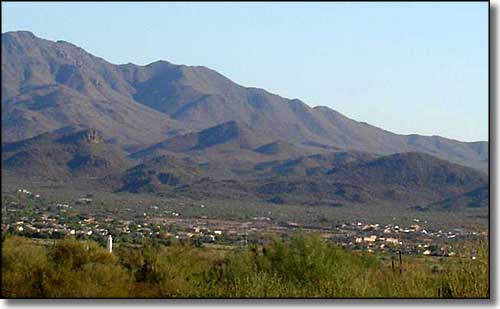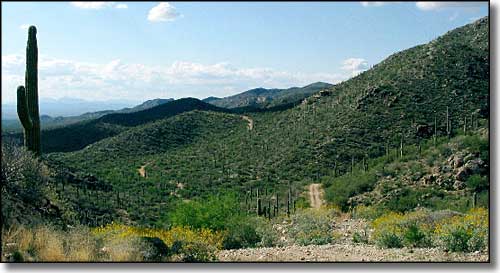
Marana, Arizona

The south side of Marana with the Tucson Mountains in the background
Marana used to be a sleepy little farming and ranching town. Then big developers moved in in the early 1990's and transformed the community into the 4th fastest growing town in Arizona. Marana used to be a small spot on the map but since 1990, the town has annexed most of the land along the I-10 between the Pinal-Pima County line and the northern boudary of Tucson, except for the area around the small unincorporated community of Rillito. The surface area of Marana is now about 120 square miles.
Marana sits in the Santa Cruz River Valley, an area that has seen almost continuous occupation for more than 4,200 years. The Hohokam people lived here a long time before the Spanish arrived, digging extensive canal systems to irrigate their crops with water from the Santa Cruz River. On his way to found the city of San Francisco in California, Juan Bautista de Anza led his men through the area. Gold miners arrived after the time of the Gadsden Purchase but nothing significant was found until someone struck high-grade copper ore in the Silver Bell Mountains around 1865. The Southern Pacific Railroad arrived in 1881 and that changed everything. As they hacked their way through the dense brush in this area, the railroad workers gave the town its name: "Maraña," meaning jungle, tangle or thicket.
Mining and ranching are the first "businesses" in the area of Marana but after World War I, farming started to take off. Cotton, barley, wheat, alfalfa and pecans were grown extensively on irrigated lands. In World War II, the Marana Airfield was built. By 1945, more than 10,000 pilots had been trained here, making Marana the largest pilot training center in the world in those days. The days of the Cold War saw the construction of a complex of Titan missile sites built around Tucson, with 5 of them located in the Marana area.
Marana began hosting the PGA Tour's "WGC-Accenture Match Play Championship" in February, 2007. The event includes the world's top 64 professional golfers and will be played in Marana at least through 2010.
When Marana became an incorporated community in March, 1977, the town occupied only about 10 square miles of land. At that point there were only about 1,500 residents. Ironwood Forest National Monument is in the Silver Bell Mountains just west of Marana.

In the mountains near Marana
Latitude: 32.3865°N
Longitude: 111.1254°W
Incorporated: 1997
Elevation: 1,991'
Education:
High School or Higher: 90.3%
Bachelor's Degree or Higher: 29.1%
Graduate or Professional Degree: 9.1%
2011 Cost of Living Index for Marana: 90.7
Estimated Median Household Income: $63,000
Estimated Median Home Value: $256,800
Median Resident Age: 34.5 Years
Major Industries:
Health Care, Transportation Equipment, Government, Construction, Educational Services, Lodging & Food Services, Finance & Insurance Services, Professional Services, Retail Services, Waste Management Services
Unemployed (March 2011): 7.8%
2010 Population Demographics
| Total Population | 34,961 |
| Males | 17,444 |
| Females | 17,517 |
| Population by Age | |
| Under 18 | 8,964 |
| 18 & over | 25,997 |
| 20-24 | 1,506 |
| 25-34 | 4,878 |
| 35-49 | 7,252 |
| 50-64 | 6,519 |
| 65 & over | 5,191 |
| Population by Ethnicity | |
| Hispanic or Latino | 7,730 |
| Non Hispanic or Latino | 27,231 |
| Population by Race | |
| White | 28,654 |
| African-American | 874 |
| Asian | 1,322 |
| Native American | 433 |
| Hawaiian or Pacific Islander | 47 |
| Other | 2,338 |
| Two or more | 1,293 |
